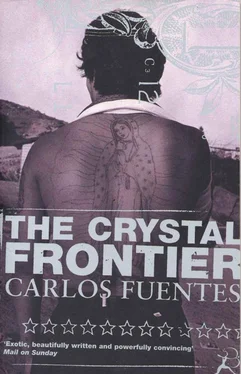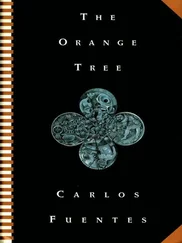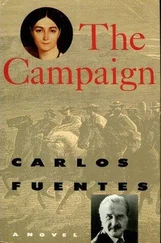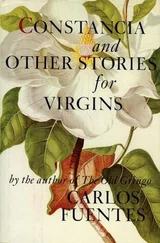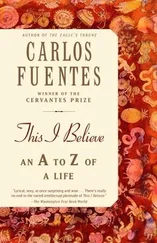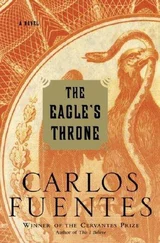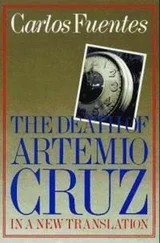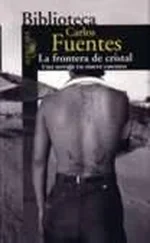“Maybe it would be better if we just went back to the hotel,” said Tarleton.
“No,” Becky practically shouted. “We’re here. I’m dying of curiosity.”
“In that case, you can go in by yourself,” said her mother.
They waited a while outside the lime-green building. Three stories high, it was in dire need of a good coat of paint. Clothes were hanging on the balconies to dry, and there was a TV antenna. At a soft-drink stand by the entrance, a red-cheeked girl wearing an apron but also sporting a permanent was busy putting bottles in the cooler. A wrinkled little old man in a straw hat poked his head out the door and stared at them curiously. On either side, a repair shop. A tamale vendor passed by shouting, Red, green, with chile, sweet, lard. The driver, Leandro Reyes, went on and on in English about debts, inflation, the cost of living, devaluations of the peso, pay cuts, useless pensions, everything messed up.
Becky reappeared and quickly got back in the car. “He wasn’t there, but his mother was. She said it’s been a long time since anyone’s visited her. Juan’s fine. He’s working in a hospital. I made her swear she wouldn’t tell him we were here.”
9
Every night, Juan Zamora has exactly the same dream. Occasionally he wishes he could dream something else. He goes to bed thinking about something else, but no matter how hard he tries, the dream always comes back punctually. Then he gives up and concedes the power of the dream, turning it into the inevitable comrade of his nights: a lover-dream, a dream that should adore the person it visits because it won’t allow itself to be expelled from that second body of the former student and now young doctor in the social security system, Juan Zamora.
Night after night, it returns until it inhabits him, his twin, his double, the mythological shirt that can’t be taken off without also pulling off the dreamer’s skin. He dreams with a mixture of confusion, gratitude, rejection, and love. When he wishes to escape the dream, he does so by intensely desiring to be possessed again by it; when he wants to take control of the dream, his daily life appears with the bitter smile of all of Juan Zamora’s dawns, sequestering him in the hospitals, ambulances, and morgues of his urban geography. Kidnapped by life, hostage of the dream, Juan Zamora returns each night to Cornell and walks hand in hand with Lord Jim toward the bridge over the gorge. It’s fall, and the trees again look as bare as black needles. The sky has descended a bit, but the gorge is deeper than the firmament and summons the two young lovers with a false promise: heaven is down here, heaven is here, face up, breathing underbrush and brambles; its breath is green, its arms spiny. You have to earn heaven by giving yourself over to it: paradise, if it does exist, is in the very guts of the earth, its humid embrace awaiting us where flesh and clay mix, where the great maternal womb mixes with the mud of creation and life is born and reborn from its great reproductive depth, but never from its airy illusion, never from the airlines falsely connecting New York and Mexico, Atlantic and Pacific, in fact separating the lovers, breaking the marvelous unity of their perfect androgyny, their Siamese identity, their beautiful abnormality, their monstrous perfection, casting them to incompatible destinies, to opposite horizons. What time is it in Seattle when night falls in Mexico? Why does Jim’s city face a panting sea while Juan’s faces nervous dust? Why is the coastal air like crystal and the air of the plateau like excrement?
Juan and Jim sit on the bridge railing and look at each other deeply, to the depth of the Mexican’s black eyes and the American’s gray ones, not touching, possessed by their eyes, understanding everything, accepting everything, without rancor, without illusions, disposed nevertheless to have everything, the origin of love transformed into the destiny of love with no possible separation, no matter how daily life may split them apart.
They look at each other, they smile, they both stand at the edge of the bridge, they take each other by the hand, and they jump into the void. Their eyes are shut but they know that all the seasons have gathered to watch them die together — winter scattering frozen dust, autumn mourning the fleeting death of the world with a red and golden voice, slow, lazy, green summer, and finally another spring, no longer swift and imperceptible but eternal. A gorge replete with roses, a soft, fatal fall into the dew that bathes them as they still hold hands, their eyes closed, Lord Jim and Juan, brothers now.
10
Juan Zamora, that’s right. He asked that I tell you all this. He feels pain, he feels shame, but he has compassion. He’s turned his face toward us.
Dionisio “Baco” Rangel became famous when he was just a kid, when competing on the radio program Junior Professors he unhesitatingly gave out his recipe for Puebla-style marrow tarts.
A discovery: gastronomic knowledge can be a source not only of fortune but of magnificent banquets, transforming the need to survive into the luxury of living. This fact defined Dionisio’s career, but it gave him no higher goal.
His ascent from mere appetite to culinary art and from there to a well-paid profession was attributable to his love of Mexican cuisine and disdain for cuisines of lower status, like that of the United States of America. Before he was twenty, Dionisio had taken as an article of faith that there were only five great cuisines in the world: Chinese, French, Italian, Spanish, and Mexican. Other nationalities had dishes of the first quality — Brazilian feijoada, Peruvian chicken soup with chiles, Argentine beef were excellent, as were North African couscous and Japanese teriyaki — but only Mexican cuisine was a universe unto itself. From Sinaloa’s chilorio, with its little cubes of pork well seasoned with oregano, sesame, garlic, and fat chiles, to Oaxaca’s chicken with mountain herbs and avocado leaves, the uchepo tamales of Michoacán, Colima’s sea bass with prawns and parsley, San Luis Potosi’s meatloaf stuffed with cheese, and that supreme delicacy which is Oaxaca’s yellow mole — two so-called wide chiles, two guajillo chiles, one red tomato, 250 grams of green jitomatillos, two tablespoons of coriander, two leaves of hierbasanta, two peppercorns — Mexican cuisine was for Dionisio a constellation apart that moved in the celestial vaults of the palate with its own trajectories, its own planets, satellites, comets, meteors. Like space itself, it was infinite.
Called upon, also in short order, to write for Mexican and foreign newspapers, to give courses and lectures, to appear on television and to publish cookbooks, Dionisio “Baco” Rangel, at the age of fifty-one, was a culinary authority, celebrated and well-paid, nowhere more so than in the country he most disdained for the poverty of its cuisine. Having appeared all over the United States of America (especially after the success of Like Water for Chocolate), Dionisio decided this was the cross he would have to bear in life: to preach fine cooking in a country incapable of understanding or practicing it. Excellent restaurants could of course be found in the big cities — New York, Chicago, San Francisco, and New Orleans (whose tradition would have been inexplicable without the lengthy French presence there). But Dionisio challenged the lowliest cooks in Puebla or Oaxaca to approach without a sense of horror the gastronomic deserts of Kansas, Nebraska, Wisconsin, Indiana, or the Dakotas where they would seek in vain for espazote, ajillo chile, huitlacoche, or agua de jamaica …
Читать дальше
